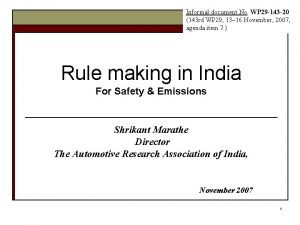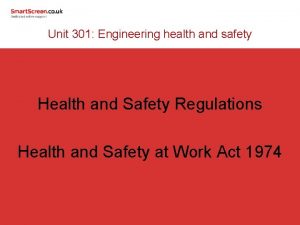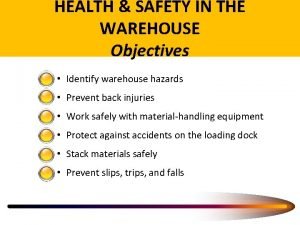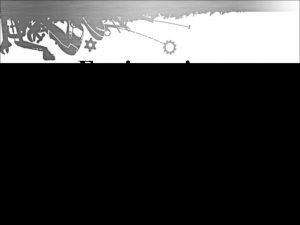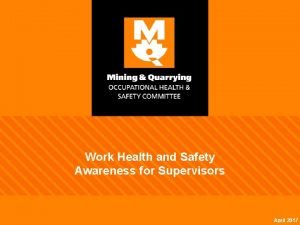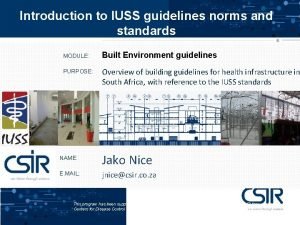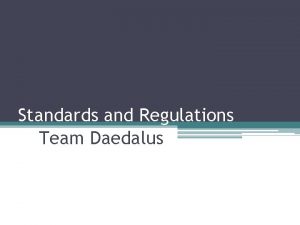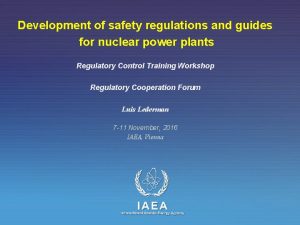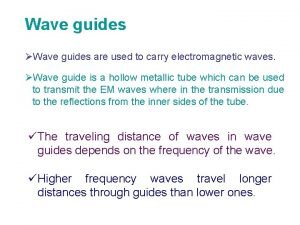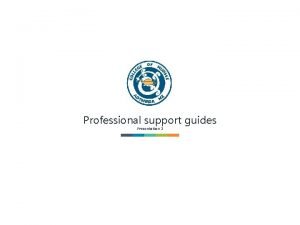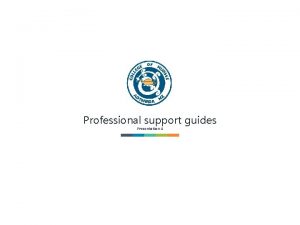RADIATION SAFETY GUIDES Radiation safety standards and regulations













- Slides: 13

RADIATION SAFETY GUIDES

• Radiation safety standards and regulations undergo continuous review and changes. These changes occur mainly as a response to a public policy based on attitudes of the public and on the philosophy of preventive conservatism, and also because of the increasing sensitivity of radiationmeasuring instruments. The continual restriction of acceptable dose limits implies that earlier limits were unsafe. However, there has been no verifiable increase in radiogenic diseases among radiation workers whose radiation doses were within the limits recommended by scientific advisory committees (the International Commission on Radiological Protection [ICRP] and the National Council on Radiation Protection and Measurements [NCRP])

International Commission on Radiological Protection • In describing its operating philosophy, the ICRP states: “The policy adopted by the Commission in preparing recommendations is to deal with the basic principles of radiation protection, and to leave to the various national protection committees the responsibility of introducing detailed technical regulations, recommendations, or codes of practice best suited to the needs of their individual countries”

International Atomic Energy Agency • The International Atomic Energy Agency (IAEA), a specialized agency of the United Nations that was organized in 1956 in order to promote the peaceful uses of nuclear energy, recommends basic safety standards that are based, to the extent practically possible, on the ICRP recommendations.

International Labor Organization Its concern generally is with the social problems of labor. Included in its work is the specification of international labor standards dealing with the health and safety of workers. These specifications are set forth in the Model Code of Safety Regulations for Industrial Establishments for the Guidance of Governments and Industries, in the recommendations of expert committees, and in technical manuals. In regard to radiation, the model code has been amended to incorporate those recommendations of the ICRP that are pertinent to control of occupational radiation hazards, and several manuals dealing with radiation safety in the workplace have been published.

International Commission on Radiological Units and Measurements • The International Commission on Radiological Units and Measurements (ICRU), which works closely with the ICRP, has had, since its inception in 1925, as its principal objective, the development of internationally acceptable recommendations regarding the following: 1. quantities and units of radiation and radioactivity, 2. procedures suitable for the measurement and application of these quantities in clinical radiology and radiobiology, and 3. physical data needed in the application of these procedures, the use of which tends to assure uniformity in reporting.

Nuclear Energy Agency • The Nuclear Energy Agency (NEA) is a division of the Organization for Economic Cooperation and Development (OECD), which is an international organization of 27 industrialized states that cooperate to further economic development among its RADIATION SAFETY GUIDES 341 members. The function of the NEA is to promote the development of scientific, engineering, and legal principles for the safe and beneficial use of nuclear energy for peaceful purposes.

International Organization for Standardization • The International Organization for Standardization (ISO) is a nongovernmental organization that is a response of industries to the globalization of commerce. Its objective is to standardize business and manufacturing practices so that customers or clients in various parts of the world will operate on a level playing field.

National Agencies Although international scientific agencies recommend radiation safety standards and practices, legal authority for radiation safety is exercised by regulatory agencies established by national states

PHILOSOPHY OF RADIATION SAFETY • Public health is that responsibility which rests on the organized community for the prevention of disease and the promotion of health. Prevention of disease through community efforts is necessary as—because of the population explosion and communal living—we are no longer able to structure our own individual environments. Our environment is determined mainly by the activities of others. The objectives of public health differ significantly from those of “private” health (clinical medicine). The aim of clinical medicine is to cure sick people, while the aim of public health is to keep healthy people healthy. A comparison of public health characteristics to “private” health characteristics is shown in the following table


The collective dose, which is a measure of the total amount of DNA damage in a population, is simply the sum of all the dose equivalents received by the individual members of a population and is expressed in person-rems in the traditional system of health physics units and in person-sieverts in SI units:

 Food safety regulations and standards
Food safety regulations and standards Automotive regulations and standards
Automotive regulations and standards Cubs and bulbuls motto
Cubs and bulbuls motto Health and safety regulations in engineering
Health and safety regulations in engineering Six pack health and safety regulations
Six pack health and safety regulations Warehouse health and safety regulations
Warehouse health and safety regulations Health and safety six pack regulations
Health and safety six pack regulations Work health and safety act 2012 sa
Work health and safety act 2012 sa Blood safety and quality regulations
Blood safety and quality regulations Anticipation guides examples
Anticipation guides examples Act 2 scene 3 othello summary
Act 2 scene 3 othello summary Unisa library
Unisa library Oom
Oom Strategic retail planning
Strategic retail planning

